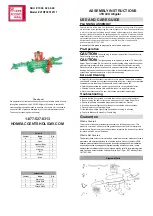
6
EN
Installation
• Do
not
over-tighten fasteners. Applying too much
torque may cause fasteners or threads to fail and
could allow the awning to collapse.
NOTICE:
Do
not
pinch the wiring or allow the wiring
to rub against sharp edges. If the wiring is damaged, it
must
be replaced by a qualified service technician.
NOTICE:
Always
use sealant on (clean) parts and
surfaces where wiring or fasteners enter the RV’s walls,
roof, or floor. Otherwise, water leakage could occur.
This section describes how to install and test the awning.
5.1 Attaching the Mounting
Brackets
WARNING: IMPACT OR CRUSH HAZARD.
Make sure the mounting surface on the RV is flat,
has solid structural backing where the fasteners
penetrate the surface, and will safely and securely
support the awning. Otherwise, the awning may
become unstable and could detach, bend, or
collapse. Failure to obey this warning could result in
death or serious injury.
I
Make sure the mounting surface on the RV is flat
and vertical. Any tilt affects the awning slope and
door clearance.
1. Confirm the gas supply is shut off, and the 120 VAC
power from the RV and the positive (+) 12 VDC
terminal from the supply battery are disconnected.
2. Determine the installation location for the awning
mounting brackets. Consider the dimensions and
clearance requirements when determining the
location. See “General Information” on page 3.
q
w
e
r
4
Marking the Bracket Holes
q
Top Line
e
Vertical Line
w
Bottom Line
r
Bracket Hole Mark
3. Position the mounting bracket in the installation
location.
4. Mark the bracket holes using a pencil.
5. Draw a horizontal line connecting the two outside
top bracket holes.
6. Draw a horizontal line connecting the two outside
bottom bracket holes
I
Due to the nature of long extruded parts, the
mounting bracket may be slightly bowed. Some
hole locations may be above or below the marked
horizontal line.
7. Draw vertical lines from each remaining hole to the
closest horizontal line and the mark the intersection
point for drilling.
8. Determine if the wall behind the location is solid or
non-solid.
A solid structure reaches from the RV floor to the roof
and matches the width of the mounting bolt pattern
behind each shoulder assembly.
– If the wall is solid, go to “Securing the Mounting
Bracket to a Solid Structure” on page 7.
– If the wall is non-solid, go to “Securing the


































